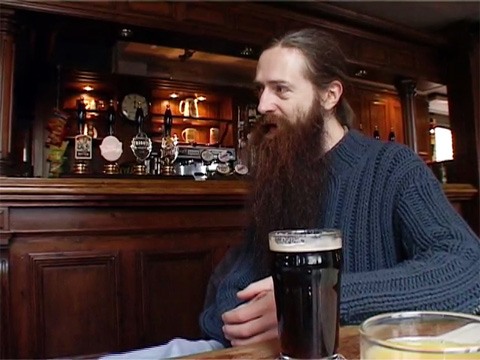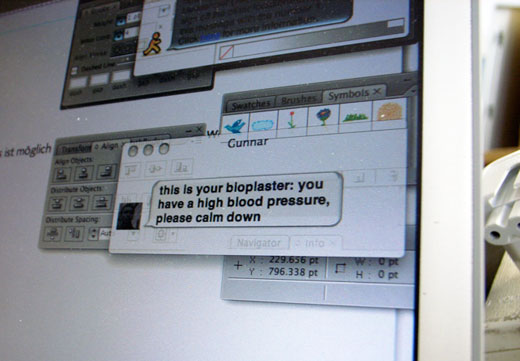Dr. Julian Vincent is the director of Biomimetic and Natural Technologies and professor of Biomimetics at the Department of Mechanical Engineering – University of Bath. He is also an associate chief editor since 2003 for the Journal of Bionic Engineering.
See more of Julian Vincent in conversation with Susana Soares, filmed by Steve Jackman.

Posted by wordpress · event · leave comment »
Having originally started in the field of artificial intelligence, De Grey worked until 2006 in the Department of Genetics at the University of Cambridge. After we created the SENS platform, an engineering project for curing human ageing and is the Chairman and Chief Science Officer of the Methuselah Foundation, a non-profit charity dedicated to combating the ageing process.
See more of Aubrey de Grey in conversation with Susana Soares, filmed by Steve Jackman.

Posted by wordpress · event · 1 comment »
“Talking with experts” was a two weeks assignment that the 4th year students at the Industrial and Interaction Design programme at Syracuse University did as part of the Environmental Design class.
The project was based on Material Beliefs, in collaboration, approach and students where taught to challenge their working methods by encouraging to talk with experts and bring them as collaborators of their work.
As described at Design and the Elastic Mind catalogue preface by “Nowadays the role of design is changing… we are looking at one of the design’s most fundamental roles: the translation of scientific and technological research into approachable objects that change people’s lives and as a consequence, their environment”
The aim of the this brief project was to enable space for students to create a collaboration between design and other disciplines, starting to depend more on experts opinions by interpreting and translating that feedback in their design projects.
The areas of interest gravitated around genetics, bioengineering, gerontology, the increase of life expectancy and ageing, regenerative technologies, tissue engineering and prosthesis and implants.
Interesting outcomes took place such as the work of the students, Jeanne Harran and Adam Karl, just to mention some examples.
Also students used their learnings to apply, afterwards, in other projects.
Initially teaming up with Ashley Waring, Jeanne and Ashley interviewed Prof. Robert Smith working at the Dep. of Biomedical & Chemical Engineering at Syracuse University. Currently he is working on cochlear implants and how can they improve the quality of life of individuals with auditory needs, at the Institute for Sensory Research. They also spoke with Joanne a research participant that received a cochlear implant after losing hearing in both ears at the age of 19th. Her implant had a great success.
However for children who were born deaf these implants have a better chance of being succeed if made at the age of 2.
Jeanne decided to take the project further and focused on the ethical issues behind cochlear implants. Since parents play a key role in the child development along with the moral responsibility to opt by an implant. However members of the deaf community believe that implanting an infant is morally wrong.
Her project is to create an interface that could help both parents and child to become part of the deaf community as well as help to carry some of the problems that they have to face with the implant.

By other hand Adam took a more problem solving approach. RJ Wattles, Evan Williams and Adam interviewed Prof. Julie Hasenwinkel working at Syracuse University L.C. Smith College of Engineering and Computer Science. Julie is researching absorbable biopolymeric gels for post-surgical tissue adhesions and new solutions for bone cements for fixation of joint replacements. During the interview they found out how cement guns were difficult to use and cumbersome. Certain cement mixing systems were also inefficient and complex.
As Adam decided to continue to collaborate with Julie team, he decided to design the implant cement injection gun.

Posted by Susana · event · leave comment »
Students and staff at the Design Interactions course at the Royal College of Art took part in a two day workshop at the Institute of Biomedical Engineering. The aim of the workshop was to provide those from the RCA with an embedded view upon biomedical technologies, and for those based at IBE to have a refreshed set of responses to their research.
The workshop included an introduction and tour from Rob Fenton – Research Development Director at IBE – with presentations from Nick Oliver and Olive Murphy, and lab experiments lead by Shahid Aziz and Thao Le.
This kicked off a four week project for Design Interactions students, with researchers at IBE and Reading taking up visiting tutor roles at the RCA through tutorial sessions, providing feedback on the projects. A project blog was set up by Cesar, to share design materials and other start points.
Additionally, Paul Thurston of Think Public, Tom Shakespeare of PEALS and Alex Wilkie from Goldsmiths were invited to provide a programme of evening lectures for students to hear about how public sector work and sociology might broaden the exchange between biomedical engineering and reflective design.
A final crit takes place on Thursday 15th May, with a morning of discussion following on friday 16th. Please get in touch if you would like to know more about this workshop, or would like to try something similar.
During a frenetic tutorial with Bernard, his digital plaster sent a message. In fact it was Gunnar, who was sat behind us.

Posted by wordpress · event · Comments Off on Design Interactions workshop at IBE
My Space, My City, My World was a three day conference for year 10 students in south east London, based at the Steven Lawrence Centre in Deptford. Material Beliefs was invited by Ignite! to run two of the workshops, other project partners included Aspire, London Engineering Projectand the Stephen Lawrence Charitable Trust. Here’s something about the event from the Ignite page:
The conference aims to build young people’s confidence in making their voices heard in the places where decisions are made about design, engineering, economics and the future.
My Space, My City, My World will explore individual students’ personal ‘footprint’, their views about the urban landscape, and the way the world is going. Workshops will be led by young, keen and green entrepreneurs, designers, scientists and engineers – and debates will explore how one person can make a difference.
On tuesday, Tony Cass and I lead a workshop an DNA profiling, which responded to technology from the Institute of Biomedical Engineering and DNA Electronics. Elio Caccavale and Mark Hammond lead a workshop on thursday based around the Animat project at the University of Reading. The aim was to encourage the students to design their own products and services around these emerging technologies.

above: a design for a cyborg

above: service design for DNA profiling
Posted by wordpress · event · leave comment »
Ros, Nick and Pantelis met at the Institute of Biomedical engineering to discuss type 1 diabetes. Pantelis is developing an artificial pancreas – a silicon chip which has the potential to replace the function of pancreatic beta cells. This technology could provide a replacement for the type of insulin pump used by Ros, who spoke about her careful management of diabetes through an “open loop” system, which depends on her monitoring the pump. As a doctor in the NHS, Nick spoke about how closing the loop on the management of diabetes could change patients’ relationship with their doctors. All three offered a different perspective on diabetes, and shared their experiences of managing it. Steve filmed the discussion, and Tobie asked some questions. A short film called Mind the Loop will be available soon.

Posted by wordpress · event · leave comment »
It was a pleasure speaking at the Dana Centre for the Techno Bodies; Hybrid Life event. Despite feeling comfortable with the technology I use in biomedical research and in clinical practice, it’s always challenging and interesting discussing bionics with people who work in different areas. In both of the sessions Tobie and I facilitated, the first question was exactly the same but the discussions diverged enormously from there, taking in telecoms technology, diabetes management, the iPhone, health economics and the utility of the bionic man. My only regrets are that we didn’t have longer to explore the issues in more detail and that I didn’t get to take part in the other discussions.
I hope all that attended enjoyed themselves and I’d be very happy to continue any discussions in the forum or offline.
Looking forward to future events,
Nick Oliver, Physician, Institute Biomedical Engineering, Imperial College
Posted by nick · event · leave comment »
Someone was resourceful enough to hack the diary section, Elio saw it first and Markus helped restore things. If you were the one who owned the blog, props to you, and can you nobly educate me about how to close the hole? Here’s more about being owned, or pwn if you prefer.

Posted by wordpress · event · leave comment »
I’ve been reading “SCIENCE AND THE NATION” which was written shortly after WWII by the Association of Scientific Workers (and an archive of material here). The book sets out a series of recommendations to allow Britain “to use all of it’s resources to take full part in international affairs, to repair the ravages of war, and to put industry on a peace-time footing”. There is a short chapter on Science as a Part of Culture, which describes a separation between science and the arts, and an under valued role of science within culture:
This is not to suggest that an interest in science is a superior attribute to an interest in the arts, but that a society’s heritage and contemporary progress in science is as integral a part of of that society’s culture as is its music and literature, and should be absorbed normally as part of general education. (page 208)
I like the idea of absorbing science, and reminded me of a chapter in a more recent book by Mike Michael, called Technoscience and everyday life. Rather than a sense of separation between communities (the “cultural intelligentsia” get an especially hard time!) and the broad principles of science, Michael’s describes how technology and science are bound to our everyday lives through the comportment of our bodies, through the use of mundane objects like Velcro fastenings or buckets and mops, as well through more exotic alterations:
Between these extremes of deep mundanity and the further shores of posthuman speculation lie bodies that are embroiled with the more or less everyday technologies of domestic and working life (cars, computer, chairs) and the more or less cutting edge techoscientific innovations, most obviously biomedicine (health communication campaigns through to stem cell therapy, genetic diagnostics, organ replacements). (page 43)
Here’s a way of considering our involvement with science and technology not through making changes to educational syllabuses or government policy, but by brushing our teeth.

Posted by wordpress · event · leave comment »
Material Beliefs is curating an evening of discussion and debate at the Dana Centre on Tuesday 22nd January. Here’s what the Dana Centre has to say about it:
Meet engineers and designers who are blurring boundaries between technologies and your body. What counts as a hybrid life form and how might it affect you?
More detail on the Dana website. Come and chat about the research driving the Material Beliefs collaborations, and find out about how you can get involved. Call 020 7942 4040 or e-mail tickets@danacentre.org.uk to pre-book, the event takes place from 19:00 Р20:30, come early and stay late with refreshments from d.caf̩.

Posted by wordpress · event · 4 comments »










